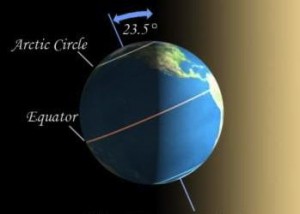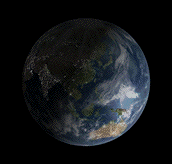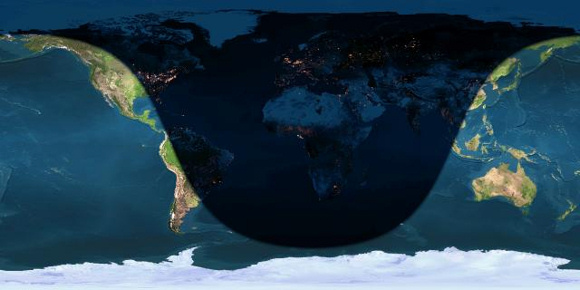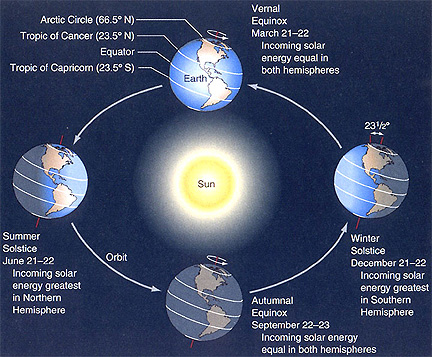Everything you need to know: December solstice 2014

 December solstice |
|

Sunlight on Earth, on the day of the winter solstice. The north polar region of Earth is in 24-hour darkness, while the south polar region is in 24-hour daylight. Gif via Wikimedia Commons.
Late dawn. Early sunset. Short day. Long night. For us in the Northern Hemisphere, the December solstice marks the longest night and shortest day of the year. Meanwhile, on the day of the December solstice, the Southern Hemisphere has its longest day and shortest night. This special day is coming up on Sunday, December 21 at 23:03 UTC (5:03 p.m. CST). A fun fact about the coming solstice is that it occurs within about two-and-a-half hours of a new moon. No matter where you live on Earth’s globe, a solstice is your signal to celebrate. Follow the links below to learn more about the 2014 December solstice.
Day and night sides of Earth on the December 2014 solstice

Day and night sides of Earth at the instant of the December 2014 solstice (2014 December 21 at 23:03 Universal Time). Note that the north polar region of Earth must endure 24 hours of night, while the south polar region gets to bask in 24 hours of daylight. Image credit: Earth and Moon Viewer
When is the solstice where I live? The solstice happens at the same instant for all of us, everywhere on Earth. In 2014, the December solstice comes on December 21 at 5:03 p.m. CST. That’s 23:03 Universal Time. It’s when the sun on our sky’s dome reaches its farthest southward point for the year. At this solstice, the Northern Hemisphere has its shortest day and longest night of the year.
To find the time in your location, you have to translate to your time zone. Click here to translate Universal Time to your local time.
Just remember: you’re translating from 23:03 UT on December 21. So for most of the world’s eastern hemisphere – Europe, Africa, Asia, Australia and New Zealand – the December solstice actually comes on December 22. For example, if you live in Perth, Australia, you need to add 8 hours to Universal Time to find out that the solstice happens on December 22, at 7:03 a.m. AWST (Australian Western Standard Time).

Earth has seasons because our world is tilted on its axis with respect to our orbit around the sun. Image via NASA.
What is a solstice? The earliest people on Earth knew that the sun’s path across the sky, the length of daylight, and the location of the sunrise and sunset all shifted in a regular way throughout the year. They built monuments such as Stonehenge in England – or, for example, at Machu Picchu in Peru – to follow the sun’s yearly progress.
But we today see the solstice differently. We can picture it from the vantage point of space. Today, we know that the solstice is an astronomical event, caused by Earth’s tilt on its axis, and its motion in orbit around the sun.
Because Earth doesn’t orbit upright, but is instead tilted on its axis by 23-and-a-half degrees, Earth’s Northern and Southern Hemispheres trade places in receiving the sun’s light and warmth most directly. The tilt of the Earth – not our distance from the sun – is what causes winter and summer. At the December solstice, the Northern Hemisphere is leaning most away from the sun for the year.
At the December solstice, Earth is positioned in its orbit so that the sun stays below the north pole horizon. As seen from 23-and-a-half degrees south of the equator, at the Everything you need to know: Winter solstice 2014 | Astronomy Essentials | EarthSky:
